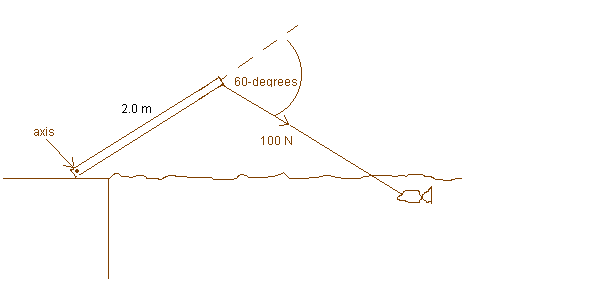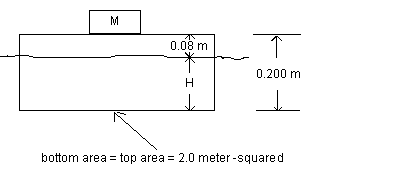
| From Autumn 2000 | Student Performance |
1. (25 points) Ch. 8. A fish pulls on a fishing pole that is propped near the edge of the shore as shown. The fish pulls with a force of magnitude F = 100 N, just like that quiz problem from Ch. 8. The angle that the force makes with a line parallel to the pole is shown to be 60 degrees. The pole is 2.0 m long. The pole can rotate about the specially constructed axis indicated in the figure.

(a) ( 23 points) What is the magnitude of the torque exerted on the
pole ?
(b) (2 points) Does the pole rotate clockwise or counterclockwise ?
| Solution : (a) Torque = 100 (2 sin 60) = 173 Nm (b) Clockwise |
2. (30 points
) Ch. 9. A mattress is partially submerged under the water. The mass of the mattress is 2.0 kg, just like that quiz problem from(a)(6 points) What is the length H that is under the water ? (This is NOT a trick question. It requires no physics, just simple algebra to answer the question. Look at the picture. )
(b) (6 points) What is the volume of the mattress under the water ? (This is NOT a trick question. It requires no physics, just simple algebra to answer the question. Use the definition of volume.)
(c) (9 points) What is the buoyant force FB acting upward ?
(d) (9 points) What is the mass M of the block ?

| Solution: (a) 0.12 m = 0.200 - 0.08 (b) VS= A(0.12) = 2(0.12) = 0.24 m3 (c) FB = (water density)VSg = 1000(0.24)(9.8) = 2352 N (c) 2352 = Mg + 2g where mass of mattress = 2 kg M = (2352 - 2g)/g = (2352 - 2*9.8)/9.8 = 238 kg |
3. (25 points) Ch. 10. An air bubble has a volume of 1.30 cm3 when it is released by a submarine 200 m below the surface of a lake, similar to that quiz problem from Chapter 10 . What is the volume of the bubble when it reaches the surface ? Assume the temperature of the air remains constant while bubble rises.
| Solution: P1 = Patm + (water density)g h P1 = 1.013x105 + (1000)(9.8)(200) P1 = 2.016x106 N P1V1/T1 = P2V2/T2 V2 = (P1/P2)*V1 = (2.016/1.013)*1.3 = 27 cm3 |
Extra Credit = 20 points !
4. Ch. 11. Lead bullets, each of mass 1.00 g, are heated to 200oC. How many pellets must be added to 500 g of water that is initially at 20.0oC to make the final equilibrium temperature Tf = 25.0 oC ? Neglect any heat transfer to or from the container
( Hint: See the hint to #11 of Quiz 10 for Ch. 11.)| Solution: See Hint to Problem 11, Ch. 11 by clicking here. Answer = 467 pellets |